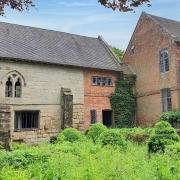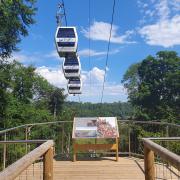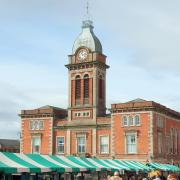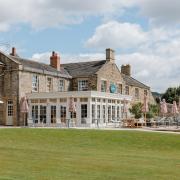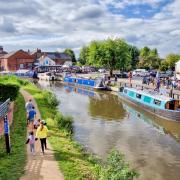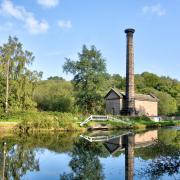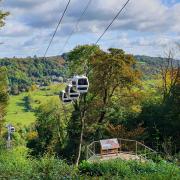How nine of Derbyshire’s towns and villages forged long-lasting links and friendships with like-minded settlements across Europe and beyond – and why they’re still going strong today.

DERBY - Osnabrück and Toyota City
Our city’s ties with historic Osnabrück, found in the Lower Saxony region of West Germany, go back 48 years, with 2026 set to herald half a century of twinning.
Osnabrück is known as the ‘City of Peace’ and is famed for its famous market, history-rich Museum Quarter and its beautiful St. Peter’s Cathedral, a late Romanesque building which dominates the city’s skyline.
Derby’s relationship with Osnabrück is based on mutual values and benefits – with the main focus, according to Derby City Council, on: creating business links between the two cities; and increasing awareness of the visitor experience in both cities and encouraging residents to visit their twinned city.
This has taken many forms over the years, from holidaying to student exchange programme, which has led to lasting friendships and connections, some dating back from the very first year of cities’ association with each other.
Earlier this year, Derby Brewing Company even announced the launch of its ‘Osnabrück unfiltered lager’, paying homage to the cities’ connection.
Derby’s twinning with Japan’s Toyota City is more recent, having been formally recognised back in 1998.
Toyota City is located in the heart of Aichi Prefecture, on the largest of Japan’s four islands – Honshu.
Known colloquially as ‘automobile city’ – and once formally known as Koromo City before being replaced with Toyota in 1959 - there’s a clear link with Derby, given its manufacturing history, prowess and Toyota’s significant presence in Derby.
Last year, a Toyota City delegation, including the city’s mayor, Toshihiko Ota, visited Derby to recognise the 25th anniversary of the partnership, with councillor Nadine Peatfield commenting at the time: ‘Over the past 25 years, the relationship between Toyota City, Derby and Derbyshire has gone from strength to strength and created many economic, cultural and educational benefits.’

CHESTERFIELD – Darmstadt and Troyes
Derbyshire’s largest town enjoys many beneficial links to foreign places across the world, including Tsumeb in Namibia and Yangquain in China.
Yet arguably the best known and most celebrated twinning links exist with the French town of Troyes and the German town of Darmstadt.
The latter is the oldest of Chesterfield’s numerous foreign links, with the twinning agreement signed in Chesterfield in 1959 and then in Darmstadt the following year.
Such Anglo-German twinning was common in the years and decades that followed the Second World War as a means of forging new ties and friendships after the horrors of the confict and many such examples can be found across Derbyshire.
In the 65 years that have followed, many close personal and organisational connections have arisen between the two towns – with numerous visits to and from Darmstadt, located in the Frankfurt Metropolitan Area, including school children, college students, sports clubs, and community groups and organisations.

Recent activity has included links forged between emergency services personnel and even folk dancers!
2019 saw the 50th anniversary of the partnership, with numerous events marking the occasion in both Chesterfield and Darmstadt, which included a beer stall in the latter selling Chesterfield-produced beers.
Chesterfield’s twinning with Troyes – described as the ‘medieval jewel of southern Champagne – was made in 1973 and is connected to the town’s connection with Darmstadt, as Darmstadt and Troyes are, themselves, twinned.
As with Darmstadt, many exchanges and activities have taken place between Chesterfield and Troyes (also known as Aube) in the decades that have followed, leading to a deep-rooted and thriving relationship between the two towns.
Currently, Chesterfield College has an ongoing link with its further education equivalent in Troyes, which has greatly benefited students both side of the English Channel.

BELPER - Pawtucket
Not all twinning partnerships are post-war collaborations. Indeed, some are the result of genuine, historic connections between two places.
The twinning of Belper with the Rhode Island city of Pawtucket, in the USA, is essentially built on one individual – Samuel Slater.
Slater’s story is no stranger to the pages of Derbyshire Life. Born in Belper in 1768, depending on your perspective he has been referred to as an American hero and a British traitor or, more locally in Belper, ‘Slater the Traitor’.
READ MORE: Why is Samuel Slater called 'Slater the traitor'?
During the Industrial Revolution, Slater took the wealth of knowledge and secrets he had acquired of industrial processes and innovations (many of which he had gained as an apprentice to Jedediah Strutt) and ran with them across the Atlantic to Rhode Island, where he created the ‘Rhode Island System’ and became vastly successful and rich in the years to come.
Slater died in 1835 in Webster, Massachusetts, a town he had founded three years earlier and named after his good friend, Daniel Webster.
At the time of his death, the Belper-born ‘Father of the American Industrial Revolution’ is believed to have been worth around £34m in today’s money.
While Slater’s reputation in the town of his birth is considerably more complex than the one he enjoys in America, the links he created over 200 years ago continue to bear fruit.
In 2019, a special concert took place to commemorate the 25th anniversary of the formal aligning of Belper and Pawtucket called ‘From Belper to Pawtucket, With Love’.
Slater’s original mill in Webster still stands, known today as the Samuel Slater Experience, a museum dedicated to preserving his history and contribution to American industry.
In Belper, a blue plaque on Chevin Road marks the birthplace of one of Belper’s most successful, yet controversial, sons.

MATLOCK – Eaubonne
Matlock Town Council was formed in 1983 and one of its first initiatives was to create a ‘friendship’ with a town on the continent – thus a relationship was formed with Eaubonne, France, which culminated in an official partnership in 1992.
Eaubonne, a suburb of Paris, is considerably larger than Derbyshire’s county town, however a closer look reveals the clear similarities which make the twinning an obvious choice.
Twelve miles or so north west of France’s capital city, Eaubonne, like Matlock, used to be a spa town and this is reflected in its name – Eau (water) and Bonne (good); translating to ‘Good Water’.
The connections between Matlock and Eaubonne have flourished ever since. A year after the formal twinning, the Eaubonne – Matlock Association was set up on the French side to forge even greater ties between both towns’ people.
Its aims at the time, as they are now, were to ‘make our English neighbours and Anglo-Saxon culture better known and better understood by promoting the development of family, educational, cultural, and social exchanges between the inhabitants of the two towns.’
At the same time, the Matlock Eaubonne Twinning Association (META) was formed in Matlock.
Close collaborations continue between the two towns, with multiple visits to Eaubonne and Matlock having taken place over the years.
In May 2018, a special twinning weekend in Eaubonne took place between May 25-28 to celebrate 25 years since the start of the twinning partnership.
A year later, it was Matlock’s turn to return the favour, with Eaubonne locals arriving in the town in June to take in a number of well-known local sites including the Heights of Abraham in nearby Matlock Bath.
Last year, Eaubonne residents didn’t actually make it to Matlock, with the meeting taking place in London due to train strikes!

WINSTER - Monterubbiano
Twinning is by no means limited to towns and cities, having been fully embraced by smaller communities too.
One such example is the pretty Derbyshire Dales village of Winster, which has been twinned with Monterubbiano, in Italy, since 1988.
A province of Fermo in Italy’s Marche region, Monterubbiano matches Winster with its rural charm and small population – although it is considerably closer to the ocean than the Derbyshire village, sitting on a hill just five miles or so from the Adriatic Sea.
The idea of the twinning of the two locations came about following a Derbyshire delegation to Monterubbiano in 1986, which included a cultural activity Winster is renowned for – morris dancing!
The first formal twinning visit occurred two years later, having been proposed by Roy Witham of Winster and Federico Vitali of Montrubbiano.
Further visits to both Winster and Monterubbiano occurred in the years that followed – primarily based around morris dancing and the sbandieratori e musici of Monterubbiano.
A period of inactivity followed but, after a period of eight years, the twinning partnership was formally revised in 2001 and since then, regular visits have continued between the two places.
‘Whilst our respective visits have tended to centre on our respective festivals La Scio la Pica at Pentecost in Monterubbiano and Winster Wakes at the beginning of July in Winster, there are now regular informal visits of families and friends between our two communities,’ state Winster Parish Council.
‘One of our principles is that visitors stay in the homes with the families of their hosts and long-term friendships are made and maintained. It is very much a twinning of the people sharing our culture and our activities and our way of life and is now a permanent feature of our respective communities.’

BUXTON - Bad Nauheim
There are similarities between Buxton’s twinning with Bad Nauheim and Matlock’s with Eaubonne in that Bad Nauheim is considerably larger than Buxton, yet both are spa towns.
Bad Nauheim sits in the Hesse state of Germany, around 25 miles north of the city of Frankfurt. The town can count Elvis Presley as a famous past resident, with the rock and roll star having lived in Bad Nauheim between 1958 and 1960 while in the US Army.
Given the clear links between Buxton and Bad Nauheim, a twinning connection had been mooted for some years, with this being formalised in 1986, heralding a decade of regular activity and collaboration between the two towns.
Activity slowed towards the end of the 20th century but was revived in 2001 by the late Jane Mcgrother, a former Buxton mayor.
Now, 37 years on from the formal twinning announcement, The Buxton/Bad Nauheim Twinning Association continues to be extremely active, with the eight-strong Buxton twinning committee holding regular meetings.
Recent activities include the creation of a Buxton Twinning Photo Trail, where, at each location, there are two photos – one of Buxton and the other of Bad Nauheim as a means of exploring the similarities and contrasts of the two towns.
While activity has become increasingly innovative in recent years, the overall vision remains the same: To promote and foster friendship and understanding between the people of Buxton and Bad Nauheim; to promote and facilitate contact between individuals, groups, organisations, societies and businesses and to hold social events; and to promote or support such other activities as may further the aims of the Association.
Buxton is also twinned with Oignies, in northern France, a fruitful and long-standing partnership which goes back to the Second World War and continues to this day.

WIRKSWORTH – Die and Frankeneau
Wirksworth’s connections with both Die (pronounced ‘Dee’) and Frankenau extend three decades, with both 30-year anniversaries celebrated in style last year.
It is an initiative led by Wirksworth Town Council in partnership with the Twinning Association, who take the lead in coordinating activities throughout the year.
Die, a small town in the south east of France, is arguably best known for its production of excellent sparkling wine (Clairette de Die) while Frankeneau is an even smaller town, found in in the Hesse region of Germany, and popular with tourists due to its picturesque rolling hills and forests.
Regular group visits are organised to one of the twin towns – or with visitors coming to Wirksworth - which usually involve the host residents welcoming visitors to their homes for the duration of their stay, thus forming close bonds in the process.
Wirksworth’s twinning commitments to both Die and Frankenau take many forms but generally encompass: Forging family and individual links; Young people's visits; School links; Musical visits; Artistic exchanges; Sporting exchanges; and Social and Community events.
Trips made by members of the Twinning Assocation are self-financed, with an array of fundraising activities undertaken to raise funds for visits, including popular foreign film evenings and the wonderful, independent Northern Lights Cinema and at the town’s famous Farmers Market.
Not even Covid-19 could prevent connections with Die and Frankeneau continuing. Although visits had to be paused, the association remained active online with a popular programme of Zoom meetings with their counterparts in France and Germany.
Last year, between June 22-26, a special ‘Welcome to Wirksworth’ event celebrated the 30th anniversary of the twinning, with visitors from both Die and Frankeneau visiting Wirksworth for four action-packed and memorable days of activities whilst also showcasing all that is great about the town.

DRONFIELD – Sindelfingen
The North East Derbyshire town of Duffield has been twinned with Sindlefingen since 1971, with a formal partnership document signed by the two respective mayors a decade later, in October 1981.
Sindelfingen lies in the southern part of Germany, around ten miles west of Stuttgart and is now a significant commercial town.
The first visit to Sindelfingen took place in 1991 – a decade on from the formal signing – as 45 Dronfield residents visited Germany, with Dronfield returning the favour a year later and such visits continued throughout the decade.
Special reciprocal visits took place in June/July 1996 to mark 25 years since the original twinning and relations between the two towns have gone from strength to strength ever since.
The Dronfield Town Twinning Federation meet regularly to discuss and plan future activity and a citizens visit from Dronfield to Sindelfingen is due to take place next month, between September 19-23.
The trip is eagerly anticipated, with the federation stating: ‘We are always surprised and delighted at the success of these visits which show how hospitable our German friends are, together with the most interesting excursions they plan for us.’
The visit will include a guided tour of Sindelfingen, a formal dinner, a day trip to Stuttgart and a visit to many of the area’s prominent attractions.
Each June, a representative from the Town Council also attends the annual International Street Festival in Sindelfingen, which takes place over three days.
Links extend further than the Dronfield Town Twinning Federation, however, with many local groups and organisations developing and strengthening their own ties.
Dronfield Henry Fanshawe School, for example, run exchange trips to a secondary school in Sindelfingen, with a trip having taken place between March 3-13 last year, with German students heading to Dronfield four months later, between July 10-17.

GLOSSOP - Bad Vilbel
A successful twinning connection between the Derbyshire market town of Glossop and Bad Vilbel has existed since 1987, which is aimed at promoting friendships between individuals, families and groups in the two towns.
The town of Bad Vilbel lies on the northern border of the city of Frankfurt in the heart of Germany and is home to just over 30,000 residents, making it a similar sized town to Glossop.
Such is the strength of connection between the two towns, there is even a street in Bad Vilbel called Glossop-Ring in honour of the partnership.
Regular social events and exchanges have taken place over the years, including a notable one from August 1-5 in 2019 which saw a group visit Glossop from Bad Vilbel, which began with an evening reception in Glossop to welcome the delegation.
A post-event correspondence from a Bad Vilbel local, Jochen Wilbert, who attended the visit, perfectly sums up the camaraderie and friendship that has been built over the years between the two towns. It reads:
Dear Friends,
Now that we are all safe back in Bad Vilbel, we would like to think back to the wonderful and nice weekend that we spent together in Glossop.
Many thanks for the beautiful picture of the glossop artist Hobson and the
teacups.
There was a lot to discover, many good conversations and new places you
showed us.
I personally discovered Buxton properly. From our excursion I am particularly reminded of the ‘Munition Room’ at Nostil Priory. It shows how important direct access to original documents was even then.
Many thanks also for the careful planning, translations, transfer from/to the
airport and for the vegan food.
Please pass on my thanks and the thanks of my fellow travellers to your organisation team.
Best Wishes,
Jochen.









